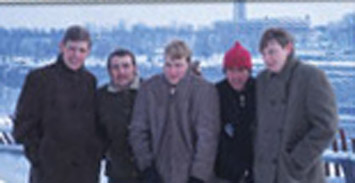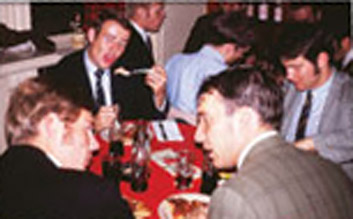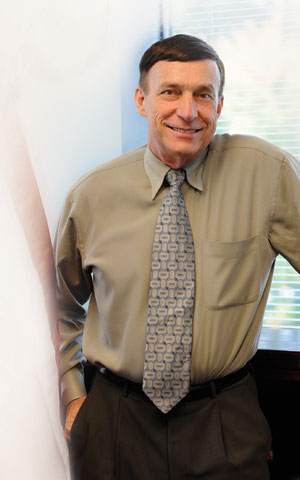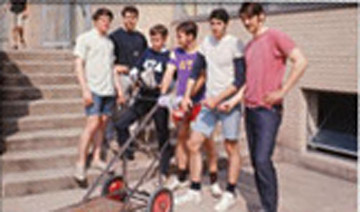
Late into the night of August 23, 1967, Pedro “Pete” Luis Rustan Jr. (EE ’70, M.S. ’70) leapt from the shores of Communist Cuba into the dark waters of Guantánamo Bay, swimming one mile to the United States Naval Station and scaling over the Cactus Curtain to freedom.
More than 43 years later—with 27 of those years in distinguished service with the United States Air Force—Rustan is still swimming.

For many who know Rustan, none would be surprised to learn that the super-achiever was recently offered the position of director of the Mission Support Directorate at the National Reconnaissance Office in Chantilly, Va. It will be the third NRO move in six years for Rustan, who has also served as director of Science and Technology as well as director of Ground Enterprise for the organization, which builds and operates the nation’s surveillance satellites. In his new role, Rustan works with the community of satellite users—other intelligence agencies, the military, law enforcement, and the Department of Homeland Security, among others—to facilitate the devices’ capabilities, including data interpretation and retrieval, the availability of various products, and the types of services offered or types that can be designed to meet a user’s needs.
When Rustan retired as a United States Air Force colonel in 1997, employment at the NRO was not on his radar. Instead, he became a successful consultant in the private sector, advising companies on matters ranging from potential aerospace projects to the latest technologies for high-speed communications links. Then the September 11 attacks occurred, and in their aftermath Rustan found that his feelings for his new country sent him on a once-familiar course.

“I’m a big patriot,” he acknowledges, regarding his return to a career in the government in 2003. “I came from a country that had a lot of problems. I thought, I’d like to pay back the United States for taking me in and giving me everything that I have. What I have is a wonderful life with the freedom to do anything that I want.”
Rustan felt his first rush of liberty after crossing an Opuntia cactus border, which Cuban troops planted along the northeastern edge of the naval base to deter Cubans from attempting to seek refuge in the United States. As luck would have it, Admiral Thomas Hinman Moorer, then chief of naval operations, was visiting the base; Rustan accompanied him to Miami and was given sanctuary at the Freedom Tower. Miami reminded Rustan too much of Cuba both culturally and politically, so he traveled to Chicago, where he got a job packing televisions for Magnavox. After three short weeks, he moved to the Rockville, Md., area, where his father’s friend helped him to obtain a position building computer modules and wiring circuit boards for Control Data Corporation.
Supplemented by loans from the Cuban Refugee Program, Rustan earned the down payment on his version of the American Dream: tuition at a prominent technology-focused university. It was something that he had desired ever since the fifth grade, when he and his classmates spent afternoons paging through magazines that featured articles on America’s national parks and institutions of higher learning.
“Poverty was my influence,” he explains. While his family was poor, his parents still found a way to send him to Guantánamo High School, where he was valedictorian and graduated at age 16. Studying at his classmates’ homes, Rustan could not help but notice their televisions and refrigerators, and that their parents had college degrees. “They had all kinds of things that my father and mother didn’t have, so I started working harder because I wanted to have more than what I saw.”

The Cuban government gave Rustan special permission to enter the Universidad de Oriente at 16 as an electrical engineering student; it also gave him his postgraduate assignment—to work in the copper mines, something he had no desire to do. He was required to perform forced labor, cutting sugar cane and harvesting rice and other crops for one month each year. On Saturdays there were military exercises, such as pretend practice in shooting down aircraft or launching missiles. At the same time, the government recognized Rustan’s accomplishments in the classroom, where he finished at the top each year, and rewarded him with sightseeing tours around the island. While he enjoyed seeing all of his country, Rustan also witnessed things that further opened his eyes to the deterioration of life in Cuba: sites where nuclear submarine bases were being built for the former Soviet Union.
“By the time I was 19, it became obvious that the situation in Cuba was not going to get any better,” says Rustan. “By that time, my father had been a political prisoner for six years, and I was continuously watched throughout college to ensure that I would not become very negative against the revolution and the Cuban government.”
With her son safe in American territory, Rustan’s mother smuggled his college transcripts to him, carried in the socks of Cubans who were employed at the naval station. Rustan’s diligence earned him entry into all three engineering schools to which he applied—Massachusetts Institute of Technology, Rensselaer Polytechnic Institute, and Illinois Institute of Technology. Shortly after he entered IIT in 1968, Rustan pledged with the Delta Tau Delta international fraternity.
“The brothers treated me very well,” he says. “The fraternity taught me about America—how to eat, how to dress, and how to socialize correctly.”
Rustan’s “Delts” fraternity brothers also benefited from knowing their new refugee friend. “He would literally work around the clock to make sure he totally understood every assignment and was totally prepared for every exam,” says Dave Zook (IE ’73), Rustan’s “little brother” and roommate, now president and owner of Horizontech, Inc. “He pushed me to work harder, but at the same time, he had a fantastic sense of humor and enjoyed to the fullest the life and the close friendships we had in the fraternity. My fraternity days at IIT were some of the best of my life, and Pete’s influence and friendship to a young kid fresh out of high school in Montana were a big reason why.”
Rustan’s pledge brother, Gary C. Masterson, business transformation consultant for Spanlink Communications, Inc., gets together with Rustan and a few other Delts every five years or so for Lou Malnati’s deep-dish pizza and bridge. Masterson recalls how Rustan and study partner Loren Vogel (IE ’72) had desks facing each other topped by hutches that Vogel made. To ensure that Rustan hadn’t nodded off, Vogel would periodically light up a cigar and blow smoke at his partner through holes drilled in the hutches. This method apparently achieved its desired effect, and then some.

“Pete provided many of the freshman engineering students in our pledge class with extra tutoring in calculus and physics,” says Masterson. One young student Rustan tutored in math went on to obtain an advanced degree in the field. Kevin Meade (MAE ’74, M.S. AMAT ’78), IIT professor of mechanical engineering, was a freshman when Rustan was a graduate student. “I remember most his passion for math and for engineering,” says Meade. “He worked very long hours, never seeming to quit.”
IIT awarded Rustan a scholarship for his master’s education, which he was pursuing when the Selective Service called his No. 16 in the draft lottery, beginning his military career. He immediately put his education to use, looking at the effects of electromagnetic interference on pacemakers and publishing his results in the Journal of the American Medical Association. Rustan became a citizen in 1971, obtained his doctorate, and as a commissioned officer attained positions of increasing significance in technological research and academia at various military installations.
In 1991, Michael Griffin, former NASA administrator, assigned Rustan as program manager for the Clementine Project, whose objectives were to test sensors and spacecraft components used for extended periods in space, and to make scientific observations of the moon and asteroid 1620 Geographos. The mission made the unexpected discovery of finding ice at the lunar South Pole.
When Rustan entered the waters of Guantanamo Bay, he shot for the moon, and indeed, hit his target.
“Pete’s life story would say, ‘Don’t give up,’ and that improvement is always possible,” offers Griffin, who left NASA in 2009 and is now an eminent scholar and faculty member at the University of Alabama in Huntsville. “Set your goals high and then achieve them. Here’s a guy who was born in Cuba under a rather vicious Communist regime, and holds a Ph.D. in electrical engineering and occupies one of this nation’s highest and most trusted positions in government. What does that tell you?”
More Online
Clementine Project: nssdc.gsfc.nasa.gov/planetary/clementine.html
Cuba: www.state.gov/r/pa/ei/bgn/2886.htm
National Reconnaissance Office: http://www.nro.gov/